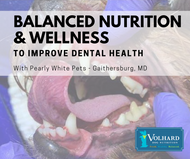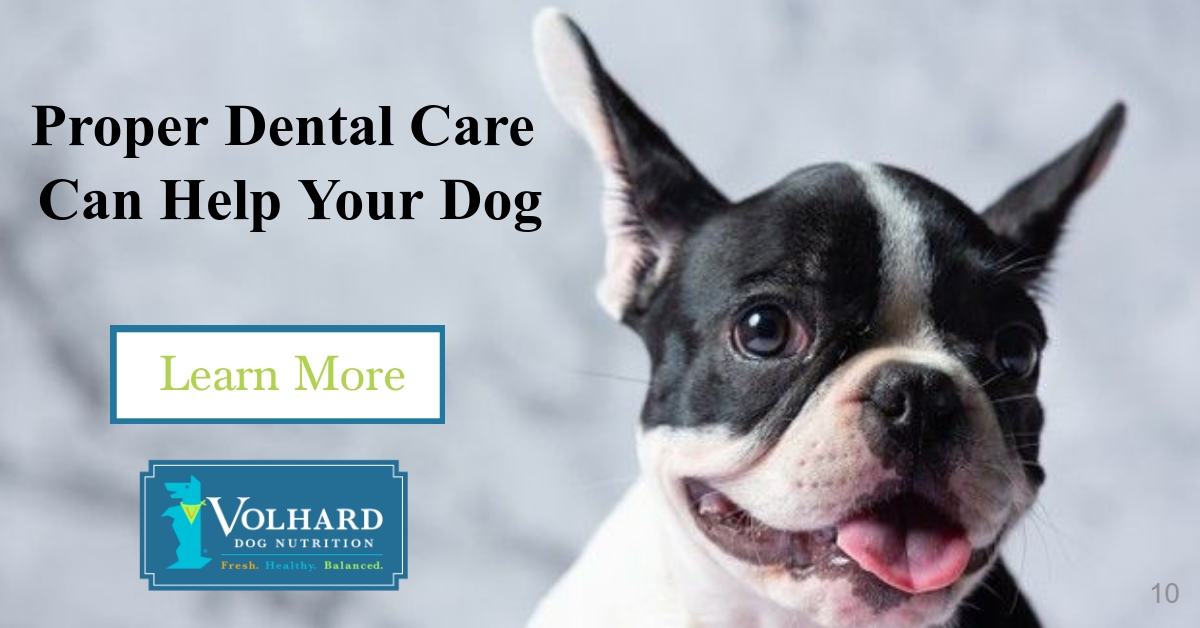Balanced Nutrition and Wellness to Improve Dental Health
Posted by Jennifer Carter on Sep 30th 2020
When most people think about good dog nutrition, they assume that the only important thing is what's in their dog's food. Well, chew on this: Teeth-that's right, teeth!-play a critical role, too. The connection may not be obvious at first glance, but if your dog has missing teeth or dental disease, they simply won't get the maximum nutritional value from their food.
People already know that unhealthy teeth and gums can contribute to serious diseases, such as heart ailments, osteoporosis, diabetes, and severely stress the immune system. The end result is that the quality of your dog's life and longevity may suffer. But I'm betting you don't know how teeth also fit into the nutrition part of this equation. We at Volhard Dog Nutrition look at the dog's health holistically and nutrition is one part of that equation- the other being wellness visits that include dental health! Remember you should have a veterinary wellness team which may include your veterinarian as a partner but also includes other wellness maintenance visits to a dentist, chiropractor, acupuncturist, etc.
For the body to do its best job of assimilating food, two things are necessary. One is a healthy digestive tract (diverse microbiome); the other is the ability and willingness to chew. Here's where the dog's anatomy comes into play. Carnivores, herbivores, and omnivores have digestive systems that are distinctly different and with teeth designed to match the needs of each system. Take dogs, for example. Dogs don't have to chew like humans as their sharp front teeth enable them to just rip, tear and swallow. Their digestive tract can handle tough animal tissue.
What role does nutrition play?
"Poor foods contribute to gum and tooth disease by several means." says homeopathic veterinarian Dr Don Hamilton. And dental disease is at epic proportions, affecting over 70 percent of dogs and cats before the age of two.
"First, and most obvious, high levels of sugars and simple carbohydrates provide rapidly available nutrition for oral bacteria," says Hamilton. "Secondly, poor nutrient quality simply does not support the immune system. Third, and probably most important, though commonly overlooked, rancid foods contribute greatly to degeneration of all body tissues. The gums are either particularly sensitive or are just easily visible, but I commonly see inflamed gums in an otherwise apparently healthy animal. In either case, this provides an early warning sign for the beginning of the chronic disease."
Feeding dogs the diet they were designed to eat a fresh food diet that's not laden with a starch like Volhard with raw meaty bones a few times a week is enough to prevent and even treat dental disease. Pearly White Pets shares Volhard's mission in educating the pet parent about proactive wellness versus waiting for a reaction to a crisis. Volhard Dog Nutrition is very particular about who advocates for our diet and we hope to work with this organization to help pet parents establish a good nutritional base from which healthy teeth and gums will thrive.
Veterinarian Sara Chapman concludes, "Raw meaty bone diets keep wild carnivores' teeth in top condition, and they can do the same for our domesticated carnivores. Even ground raw diets help prevent tartar build-up, as the meat contains natural enzymes, and raw diets do not stick to the teeth, unlike diets that are high in starch. Kibble has long been touted as helping keep teeth clean because of its abrasive action. Have you ever watched your dog eat kibble? You have surely noticed that they don't chew the stuff, they swallow it down whole. While some of us have dogs that do not exhibit tooth issues, other of us have dogs that are genetically predisposed to weak teeth that are structurally prone to plaque buildup, crowding and tooth loss.
Canine periodontitis is a bacterial infection of the mouth. There are four stages of periodontal disease, progressing from plaque and mildly inflamed gums to established gingivitis (gum disease), and then on to mild and ultimately severe periodontitis, which may involve bone and/or tooth loss.
But with a good at-home dental care routine and regular professional dental cleanings, you can help prevent your dog from getting a dental disease.
Looking for Signs of Dental Disease in Dogs
The first thing you can do at home is to simply look for signs of dental disease. Flip your dog's lip, and ask yourself 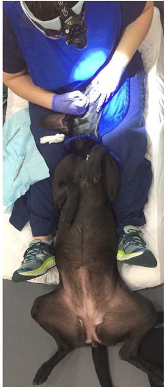 these questions:
these questions:
If you answered any of these questions with a yes - you need to pay attention to your dog's diet and their teeth and gums.
So what is a way to maintain your dog's teeth but manage the risk of putting your dog under anesthesia every year?
You might have heard about anesthesia-free dental cleanings from a local groomer, pet store, word of mouth or even some veterinary providers. Commonly known as anesthesia-free dental cleanings, the practice involves scaling (scraping with an instrument) of a dog's teeth without putting the dog under anesthesia. This author just experienced a procedure with her Yorkie called Anesthesia Free Dental cleaning with a company called Pearly White Pets in Maryland. This month's blog will share that experience with you so you can make your own informed decision about this type of wellness for your dog's teeth and gums.
Veterinarians often refer to the practice of scaling the teeth without anesthesia as
non-anesthesia dental scaling (NAO or NADS), as the term "cleaning" is misleading to pet owners who have the impression that after one of these procedures, their pet's mouth is clean and healthy. It may sound like a great option, but what exactly does this procedure involve?
The method, as its name suggests, is a process in which your dog's teeth are cleaned without the use of anesthesia. This appeals to pet owners who are nervous about having their dog anesthetized, or who own elderly or large breed pets that are more likely to have complications under general anesthesia. If your dog's teeth are high maintenance this may be an option for in-between regular vet cleanings so your dog does not need to be put under anesthesia over and over again.
One criticism of this procedure is that the dogs are subjected to trauma during the process and they may squirm and
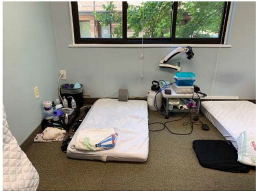 put themselves at risk with sharp scaling objects around. I am not sure that the dogs experience trauma if the procedure and pet handling are done correctly and with sensitivity to the dog's needs. This dog is completely relaxed and comfortable getting regular tooth cleanings because he was introduced to it and goes regularly. I made the decision to try this because I have a 9.5-year-old Yorkie and I wanted to help her eliminate some tooth buildup without having to put her under anesthesia.
put themselves at risk with sharp scaling objects around. I am not sure that the dogs experience trauma if the procedure and pet handling are done correctly and with sensitivity to the dog's needs. This dog is completely relaxed and comfortable getting regular tooth cleanings because he was introduced to it and goes regularly. I made the decision to try this because I have a 9.5-year-old Yorkie and I wanted to help her eliminate some tooth buildup without having to put her under anesthesia. The Experience:
Upon arrival, the waiting room was very comfortable and if there were not dog beds you would think you were in a professional dental office. I was informed that the procedure would take about 40 minutes and was shown the room where the cleaning would take place.
The dog was brought into this room and was allowed to acclimate to it with the technicians close by to comfort them.
The cleaning process begins with my dog being positioned in the technician's lap on the floor. After the technician spends a few minutes bonding with the dog, they swaddle the dog to help the dog feel safe and work to continue toward a comprehensive oral exam.
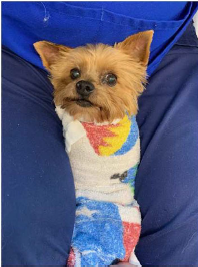
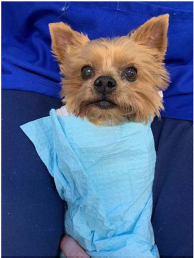
Swaddled little baby Fitted with a dental bib
The vet dental technicians wait until the dog is settled and comfortable and then the process of removing all calculus, plaque and tartar buildup using specialized tools and pet handling techniques commences. The dog is provided a supra-gingival scaling, subgingival scaling, and full periodontic probing. All of the results are charted using proprietary software. Once this procedure is complete, the teeth are polished. The dog's mouth is completely rinsed and a post-cleaning exam is conducted and results placed on a dental report card. The vet/ dental technicians reminded me that this teeth cleaning is just one important part in maintaining my Yorkie's oral health, and encouraged me to share this information with my veterinarian. Here are the results of my dog's chart with pictures so you can see the obvious result of the tooth and gum cleaning.
My Yorkie's Summary of results:
The dental disease in my Yorkie's mouth was moderate to advanced. During the cleaning they found the following:
•Mild gingival recession (Less than 25% reversible attachment loss) to Moderate gingival recession(~ 25% attachment loss)
•Grade 4 gingivitis (Heavy inflammation and bleeding from the gum-line)
•No loose teeth
•No mobile teeth
•10 missing teeth (105,106,109,110,210,305,306,311,406,411)
•No pocketing along the gum-line around any of the teeth
•Tooth 208 is fractured (Complete)
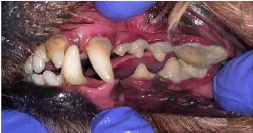
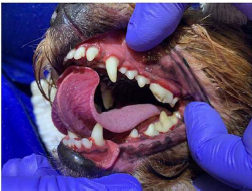
Left side before cleaning Left side after cleaning
Gums were red when the procedure was done due to irritating tartar that was removed from under the gum line. Within 5 hours of this picture, there was no redness in the mouth and the red gumline was returned to a healthy pink.
My dog's results were professionally charted and I was provided with a comprehensive dental report that I could share with my veterinarian for further dental planning. My yorkie was not distressed after the procedure, relieved herself normally, was active and ate normally that evening. I completely agree that this type of cleaning does not replace the role of the vet in your dog's dental health, however, that doesn't mean that getting anesthesia-free cleaning is worthless to me. Again, using logic, I believe that removing the majority of bacteria on a dog's teeth is helpful. According to an article by Martin Downs Animal Hospital - Anesthetic-free pet teeth cleaning - an educated view: "In the early stages of tartar build-up and gingivitis (stage 1 or stage 2 dental care], the pet's teeth can be cleaned effectively without anesthesia. A recent double-blind study on this subject was published in Integrative Veterinary Care Journal confirming the validity of non-anesthetic teeth cleaning in pets. The study finds: "After the Professional Outpatient Preventative Dentistry (POPD) was completed, no residual plaque or calculus was detected on any dogs or cats and there were no post-treatment complications. Although a POPD is not intended to be a substitute for anesthetic dentistry, it may prove to be a valuable supplemental treatment."
The study referenced, published in the fall issue of Integrative Veterinary Care Journal, examined the teeth of pets who had the anesthesia-free cleaning procedure done. The "after" examination included inspection for any remaining calculus under the gums, full mouth X-rays, and a complete oral exam. After the POPD was completed, according to the study, the board-certified veterinary dentist found no residual plaque or calculus on any of the dogs or cats.
There is some controversy surrounding the study. One of the reasons is that the sample size was small. However, I think it's a step in the right direction to prove that this procedure can be an effective preventative care technique. You can read more about the study, and the American Animal Hospital Association's (AAHA) opinion of the study, in the article AAHA Dental Anesthesia Mandate Comes Under Fire.
It is very important that this procedure be performed by a veterinarian, or a trained technician who is certified with the American Society of Veterinary Dental Technicians and work under a veterinarian's supervision, or a human dentist that does this procedure. This is what distinguishes POPD from the "cleaning" done by groomers, pet store employees, at boarding facilities, and during house calls.
So time will tell whether I notice plaque building up on her teeth more quickly after this procedure than it would otherwise. I believe that the rate at which it accumulates will be more dependent on the food I am feeding and her predisposition for tooth issues genetically, along with the number of opportunities I give her to chew on something.
For a fair and seemingly unbiased article on anesthesia-free teeth cleaning for dogs, see this article by The Whole Dog Journal.
"Your dog can't be healthy without healthy teeth and gums"

